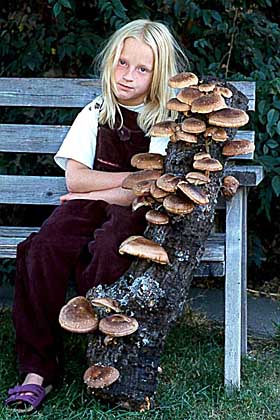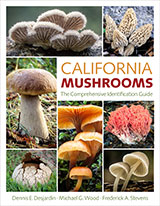Mushrooms in the Garden
This article first appeared in Mushroom: the Journal of Wild Mushrooming. Subscriptions are $25 for four quarterly issues from Mushroom the Journal, 1511 E. 54th St. Chicago, IL 60615.
Have you ever considered growing mushrooms in your garden? A wide variety of fungi possess qualities of edibility and/or aesthetic beauty appropriate for both the flower and kitchen gardens, or even for general landscaping. They may be grown with no greater effort than that required for plants.
In fact, many varieties will thrive nicely with little or no maintenance. For example, (the delectable Shaggy Mane) would feel right at home in and around your compost pile. The immense stature of the stunning purple-capped, black-gilled Stropharia rugoso-annulata may thrive in an area where lawn and woodchip mulch are in proximity, or between rows of straw-mulched vegetables or fruit trees.
.jpg)
Edible Tricholomas growing in a Garden in Thailand. Photo © Taylor F. Lockwood.
Agaricus species (the Portobello, the Prince, the Horse Mushroom, etc.) are adaptable to grassy areas among trees. Pleurotus species (Oyster mushrooms) are easily grown on a variety of substrates including straw, wood chips, shavings or sawdust -- and even whole hardwood logs. There are boundless possibilities if you let your creativity and imagination guide you.
Intrigued? But wondering how to get started?
You should begin by taking a fresh view of your garden or landscape from a new perspective; analyze its "fungamentals." List or diagram its various micro-habitats with an eye toward the qualities important to fungi. Take note of existing substrates -- lawn, treed areas, shrubs and other plantings, newly cut hardwood logs, compost areas of kitchen scraps, branch chippings, grass clippings, manures and mulches of wood chips, straw, etc.
Note conditions of sun and shade, wind and humidity. Determine if any areas may be readily amended to improve the conditions for fungi, the most important of which are warmth, moisture and humidity, along with the proper nutrients and digestible materials.
The beautiful irony is that many substrates suitable for fungi are also beneficial to the garden itself, and most can be obtained for little or no investment, as they are often considered "waste materials" or by-products. Furthermore, the required humidity and protection from direct sunlight can be maintained by your leafy plants, shrubs and trees.
Once you have considered the possibilities, you should determine what mushroom varieties are suitable and desirable. This is a great opportunity to really get to know your mushrooms. Understanding what they need in order to produce fruit bodies will even help you to seek out and find them more easily in the wild. Why, you might ask?
Because you will more quickly analyze and interpret the conditions and microclimates which favor their growth. Here are some clues about the natural predispositions of several varieties, and the analogous conditions in your garden.
Coprinus comatus
The Shaggy Mane is frequently found along roadsides and in meadows, lawns, park grounds, sports fields, old composting locations and newly planted grass. It favors nutrient rich soil. It can enliven a lawn, the bare rows between shrubs or vegetables, or may fruit gregariously in and around your compost heap.
.jpg)
The delicious Shaggy Mane. Photo © Brother Alfred Brousseau.
Commercially obtained or home-grown spawn is mixed into the top layer of compost, wood chips or straw, and covered with a thin layer of peat moss. This mushroom may become a permanent resident of your lawn if you place spawn under patches of turf.
Macrolepiota procera and M. rachodes
The Parasol and Shaggy Parasol are often discovered in grassy patches in forests and along their edges, on hillsides, along paths, in parks and gardens, sometimes under solitary trees. They prefer a somewhat sandy subsoil and adequate moisture.
.jpg)
The delicious Shaggy Parasol. Photo © Fred Stevens.
In the garden, they are likely to flourish in composting areas of either kitchen scraps or lawn clippings. Mix the topmost layer of compost with some peat moss and mix in either cultivated grain spawn or the water and trimmings from last night's Parasol dinner. Cover with leaves to retain moisture.
Laccaria amethystina-occidentalis (and related species)
The Amethyst Deceiver is often found in tremendous abundance in the woods, especially along paths, and would bring welcome color (a light, bright bluish-purple, as the name suggests), to shady areas around trees and shrubs in humus-rich soil. What it lacks in size, it makes up for in quantity, and is considered by some a highly prized edible.
Lepista nuda
The Wood Blewit is often found in duff under trees in the forest. In the garden, it is a charming addition to treed lawns and other wooded areas, along the edges of shrubbery or in fruit orchards. The soil should be amended with partially decomposed leaf or needle litter, and kept moist. Blewits will often form a brilliant ring of purple fairies around the base of trees.
Pleurotus ostreatus
The Oyster Mushroom is a saprophytic species which happily digests fallen wood in the forest. It likes high humidity and thus is often discovered fruiting from trees and logs which have fallen across a creek. In the garden, it may be grown on decorative arrangements of logs through inoculation via "plugs."
.jpg)
Oyster mushrooms fruiting from Terri Beauséjour's planter box. Photo © Michael Wood.
Oysters are a versatile lot, and have been successfully grown on a wide range of materials such as straw, bagasse, wood fibers, cotton processing wastes, paper wastes, corn stover, tea leaves, rice hulls, and even on coffee mulch in orchards -- the list goes on and on. "Blocks" of these materials may be buried among your plantings. The plants provide important humidity and a strategically placed misting sprinkler will also help.
Many cultivated species are available in a rainbow of colors and a wide range of statures, rivaling the finest flowers in their beauty and variety. Some readily available cultures are the white to fawn colored Florida Tree Oyster (P. ostreatus florida), the chocolate brown Abalone Oyster (P. cystidiosus), the Blue Capped Oyster (P. columbinus and P. ostreatus) the Golden Oyster (P. cornucopia and P. citronopileatus) and the striking pink, delicately formed Strawberry Oyster (P. flabellatusa and P. eos).
And Oyster mushrooms are one of the easiest varieties to grow and fruit.
.jpg)
Oyster mushrooms fruiting from Terri Beauséjour's planter box. Photo © Michael Wood.
Stropharia rugoso-annulata
The Garden Giant, or Wine Cap, grows naturally in gardens, on rotten straw like old haystacks, and on decomposing wood chips. It may be incorporated among dwarf fruit trees, implanted in trenches or frames, or installed between vegetable rows where an occasional dose of straw mulch is applied. Again, the trees and vegetables will provide some shade and humidity. The Garden Giant tends to fruit during the warm summer months, just in time for you to fire up that grill and break out the sangria.
Agaricus augustus
The Prince grows primarily in the duff under conifer forests. It may therefore be introduced to the garden under conifer trees and shrubs. Apparently it is particularly fond of spruce. Although commercial spawn may be difficult or impossible to obtain, you would be wise to mix any trimmings from your culinary collections with some needle litter, introduce the mixture to your conifers, and keep the area moist.
You may also have success with growing from sterile tissue or spore cultures if you are technically inclined. Agaricus grow relatively slowly in agar and on spawn, so do not be discouraged, but be patient. Adding a bit of sterilized, partially decomposed needle litter to your agar and spawn may help speed the growth. This beautiful and highly prized edible is certainly worth a little extra effort.
Agaricus bisporus and Agaricus arvensis
The Portobello, Horse Mushroom, and other meadow type Agaricus species are to be found in fields, grassy areas, at the edges of forests and in cow pastures. In the garden, composted horse manure may be mixed with straw, spawn inoculum and soil. This preparation is then incorporated in the area of choice. You may even cut a small disk out of sod or lawn, add the mixture, replace the disk and keep well watered. Agaricus prefers a substrate which is not too high in acidity, so a little bit of agricultural lime is often beneficial -- a Ph of about 7.0 is recommended.
Lentinula edodes
The Shiitake mushroom grows in open woodlands on the dead wood of broadleafed trees such as oak, alder, birch and beech. In the garden, logs may be inoculated with commercially available plugs and arranged vertically, perhaps partially buried to maintain uprightness and to preserve moisture. The mycelium will travel along the length of the log to permeate it, then will begin to fruit seasonally for up to 15 years, depending on the size of the log and the favorability of conditions. The logs must not be allowed to dry out. Here again, a misting sprinkler is your friend.
 |
In Bolek Kuznik's backyard, his daughter Eliza displays a successful fruiting of Shiitake. |
Hericium erinaceus
The Monkey Head or Pom-Pom mushroom is a snow white coral mushroom resembling a cascade of stalactites bursting forth from decaying wood in the forest. It is very easy to grow in the garden on straw or sawdust "blocks" or in bags, providing it is in an environment of high humidity. It will enliven the darkest of crevices, is an excellent edible, and according to Asian lore, eating this mushroom will increase vitality and vigor.
Morchella esculenta and M. angusticeps
Morels are often discovered in newly landscaped areas in fir bark mulch. In the spring, they frequently appear in areas disturbed by excavation, burning, off-road travel, landscaping and flooding. In the garden, a substrate may be prepared from composted household and garden residues. The patch should produce mushrooms the next spring, if adequate moisture is provided.
Morel "kits" are becoming widely available commercially -- they come with detailed instructions and are highly recommended as the best way to get started with this slightly more challenging, but worthy genus.
What about Chanterelles, Boletes and other mycorrhizal species?
You may have the good fortune to naturalize some of these in your garden, but their requirements are much more stringent and far less well understood than the requirements of the various saprophytes we have discussed thus far.
It is significantly more difficult to understand and recreate the symbiosis between the plant or tree, the fungus of choice, and the other beneficial or necessary fungal or bacterial organisms that form the relationship. There is also the lack of commercially available spawn, and growth on agar is slow to nil.
However, do not be completely discouraged, as there have been limited successes in cultivation and fruiting of mycorrhizal fungi. For example, some commercial production of truffles is now accomplished through inoculation of seedlings, and it is possible to mail-order truffle-inoculated hazelnut and oak seedlings for your own garden.
It is essential to begin by inoculating young seedlings, or by sprouting the tree seeds directly in sterile agar culture containing spores or tissue from the mushroom variety of choice. In preparation for this adventure, which is potentially very rewarding) it would behoove you to do as much reading and research on the subject as possible, and to possess a high degree of optimism and the patience of a saint.
Obtaining Cultures and Spawn
The varieties presented here, and many others, are available commercially at a fairly reasonable price. Certainly the price of a given culture or kit is within the range of the average potted plant purchased at a nursery. You may also collect and grow your own cultures and spawn. There are several excellent books on the subject of mushroom growing, and there are now a plethora of internet sites offering valuable information, methods and techniques, supplies and sources.
Sharing your Success
Once your mind becomes open to the possibilities, there is hardly a limit on what you can achieve in your garden of fungi. If you are the first on your block with a vibrant and flourishing mushroom garden, you will certainly be the envy of your neighbors and friends, and the talk of the town. Your enthusiasm for this whole new dimension of gardening may well be contagious!
.jpg)
Edible Tricholomas growing in a Garden in Thailand. Photo © Taylor F. Lockwood.
Sources
For this article Terri Beausejour used Mushrooms in the Garden by Hellmut Steineck (Mad River Press) and the handout "Mushroom Information" by Bill Chalmers of Western Biologicals as sources for some information on species she has not grown herself.
Other sources of mycological supplies, cultures, garden kits and growing information:
Fungi Perfecti, P.O. Box 7634, Olympia WA 98507; telephone 800 780-9126, fax 360 426-9377; e-mail: mycomedia@aol.com; web: www.fungi.com
Gourmet Mushroom Products, P.O. Box 515, Graton CA 95444; telephone 707 829-7301; fax: 707 823-9091; e-mail: mushroom@arrowweb.com; web: www.arrowweb.com/MUSHROOM/
Mushroom Adventures, 355 Serrano Drive, Suite 9J, San Francisco CA 94132; telephone 415 586-4082; web: www.mushroomadventures.com
Mushroompeople, The Second Foundation, 560 Farm Road, P.O. Box 220, Summertown TN 38483-0220; telephone 615 964-2200, fax 800 386-4496; e-mail: mushroom@thefarm.org; web: www.thefarm.org/mushroom
Truffle trees (hazelnut and oak), from Frank Garland, telephone 919 732-3041
Western Biologicals, Ltd., P.O. Box 283, Aldergrove B.C. Canada V4W 2T8, telephone/fax 604 856-3339, e-mail: western@prismnet.bc.ca
The Mushroom Cultivator, A Practical Guide to Growing Mushrooms at Home, by Paul Stamets and J.S. Chilton, Agarikon Press
Growing Gourmet and Medicinal Mushrooms, by Paul Stamets, Ten Speed Press
Growing Wild Mushrooms, by Bob Harris, illustrated by Susan Neri, Wingbow Press
 |
Terri Marie Beauséjour (Bo' say zhur) is a past-president of the Mycological Society of San Francisco and was chair of the society's Cultivation Committee. When not on the road to mycological adventure and discovery she works as a senior software engineer for a leading computer-aided design firm. She can be reached by email (russula@home.com) or by regular mail c/o Mycological Society of San Francisco, PO Box 882163, San Francisco CA 94188-2163. |

